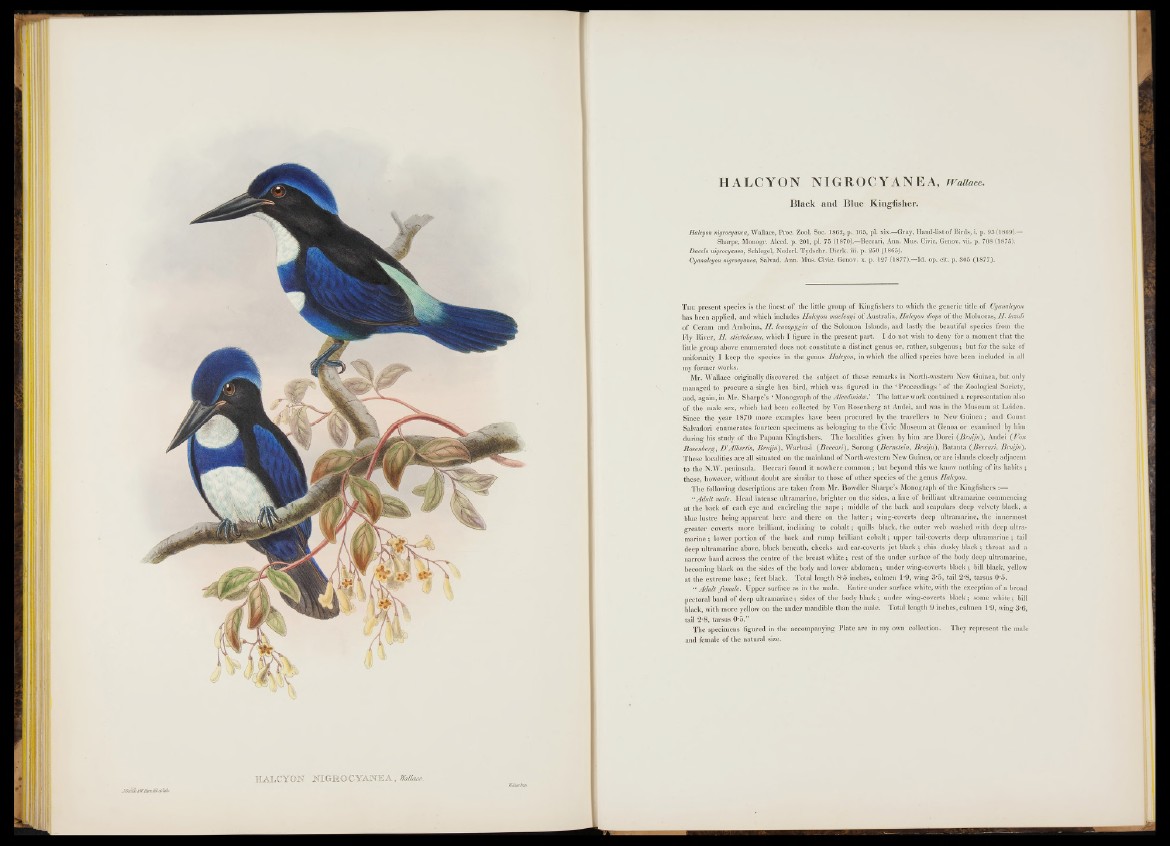
HALCYON" H I6H O CYANEA, Wallow
J6taitTf3n.3eletlUh'.
HALCYON NIGROCYANEA , Wallace.
Black and Blue Kingfisher.
Halcyon nigrocyanea, Wallace, Proc. Zool. Soc. 1862, p. 165, pi. six.—Gray, H and-listof Birds, i. p. 93 (1869).—
Sharpe, Monogr. Alced. p. 201, pi. 75 (1870).—Beccari, Arm. Mus. Civic. Genov, vii. p. 708 (1875).
Dacelo nigrocyanea, Schlegel, Nederl. Tydschr. Dierk. iii. p. 250 (1865).
Cyanalcyon nigrocyanea, Salvad. Ann. Mus. Civic. Genov, x. p. 127 (1877).—Id. op. cit. p. 305 (1877}.
T he present species is the finest o f the little group o f Kingfishers to which the generic title o f Cyanalcyon
has been applied, and which includes Halcyon macleayi o f Australia, Halcyon diops o f the Moluccas, H. lazuli
o f Ceram and Amboina, H. leucopygia of the Solomon Islands, and lastly the beautiful species from the
Fly River, H. stictolcema, which I figure in the present part. I do not wish to deny for a moment that the
little group above enumerated does not constitute a distinct genus or, rather, subgenus; but for the sake of
uniformity I keep the species in the genus Halcyon, in which the allied species have been included in all
my former works.
Mr. Wallace originally discovered the subject o f these remarks in North-western New Guinea, but only
managed to procure a single hen bird, which was figured in the ‘ Proceedings ’ o f the Zoological Society,
and, again, in Mr. Sharpe’s ‘ M onograph o f the Alcedinidce.’ The latter work contained a representation also
of the male sex, which had been collected by Von Rosenberg at Andei, and was in the Museum a t Leiden.
Since the year 1870 more examples have been procured by the travellers to New G u in ea; and Count
Salvadori enumerates fourteen specimens as belonging to the Civic Museum at Genoa or examined by him
during bis study o f the Papuan Kingfishers. The localities given by him are Dorei (Bruijn) , Andei (Von
Rosenbero-, D'Albertis, Bruijn) , Warbusi (Beccari), Sorong (Bernstein, Bruijn) , Batanta (Beccari, Bruijn).
These localities are all situated on the m ainland o f N orth-western New Guinea, o r are islands closely adjacent
to the N.W. peninsula. Beccari found it nowhere common; but beyond this we know nothing of its habits ;
these, however, without doubt are similar to those o f other species o f the genus Halcyon.
T h e following descriptions are taken from Mr. Bowdler Sharpe’s Monograph of the Kingfishers :—
“Adult male. Head intense ultramarine, brighter on the sides, a line o f brilliant ultramarine commencing
a t the back o f each eye and encircling the n a p e ; middle o f the back and scapulars deep velvety black, a
blue lustre being apparent here and there on the l a t t e r ; wing-coverts deep ultramarine, the innermost
g reater coverts more brilliant, inclining to co b a lt; quills black, the outer web washed with deep ultra-
marine ; lower portion o f the back and rump brilliant co b a lt; upper tail-coverts deep u ltramarine; tail
deep ultramarine above, black beneath, cheeks and ear-coverts je t black ; chin dusky black ; throat and a
narrow band across the centre o f the breast w h ite ; rest o f the under surface o f the body deep ultramarine,
becoming black on the sides o f the body and lower abdomen; under wing-coverts black ; bill black, yellow
a t the extreme b ase; feet black. Total length 8-5 inches, culmeu 1*9, wing 3 5 , tail 2-8, tarsus 0 5 .
“ Adult female. Upper surface as in the male. Entire under surface white, with the exception o f a broad
pectoral band o f deep ultramarine; sides o f the body black ; under wing-coverts black ; some white; bill
black, with more yellow on the under mandible than the male. Total length 9 inches, culmen 1-9, wing 3 ’6,
tail 2 '8 , tarsus 0 5 . ”
T he specimens figured in the accompanying Plate are in my own collection. They represent the male
and female o f the natural size.